Menus
- 1000cc travel enduro bikes with two, three and four cylinders
- 1000cc travel enduro in the test
- Suzuki V-Strom 1000 with the smoothest load change reactions
- Triumph Tiger 1050 Sport is an emotional flatterer
- Kawasaki Versys 1000 with beefy thrust
- Versys – cheeky like an athlete, comfortable like a tourer
- Pushing and maneuvering? Preferably the Suzuki V-Strom 1000!
- Basic engines have already proven their durability in long-term tests
- Technology engine science
- V-Strom with two spark plugs per cylinder
- Performance measurement
- Equipment in detail
- Data and measured values
- MOTORCYCLE test results
- MOTORCYCLE scoring
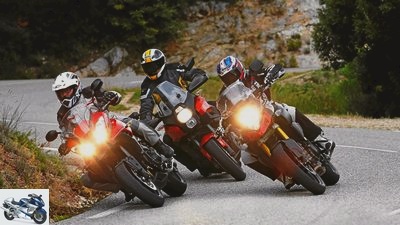
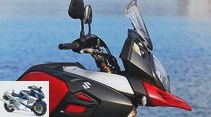
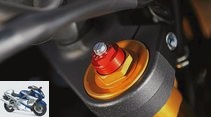

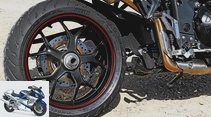
37 photos

1/37
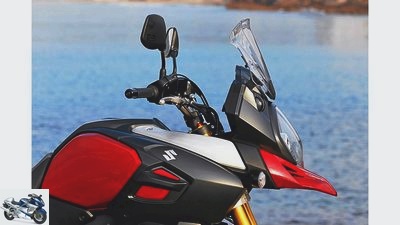
2/37
Suzuki V-Strom 1000: Exclusive: Suzi’s disc is height-adjustable and its inclination can be adjusted in no time at all without tools.
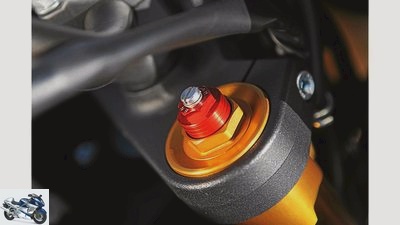
3/37
Suzuki V-Strom 1000: Gold for Japan, even without Sochi: stable, beautiful and just as fine as fully adjustable 43 mm upside-down fork.

4/37
Suzuki V-Strom 1000: That’s better: large pillion passenger handles and luggage rack, great usable luggage hooks (hidden in the photo).
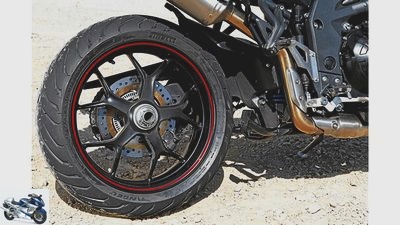
5/37
Triumph Tiger 1050 Sport: Finely polished: individual single-sided swing arm, shapely cast wheel with central nut and red rim decoration.
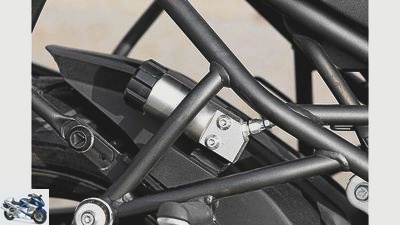
6/37
Kawasaki Versys 1000: This is how it works: As with Suzuki’s V-Strom, the spring base is adjusted hydraulically using a practical handwheel.
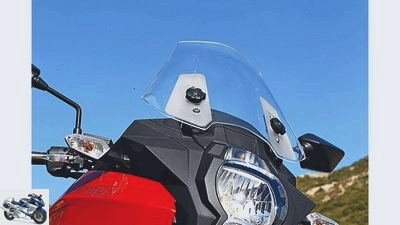
7/37
Kawasaki Versys 1000: Well thought out: In contrast to the Suzuki, knurled screws allow the height of the disc to be adjusted in next to no time.
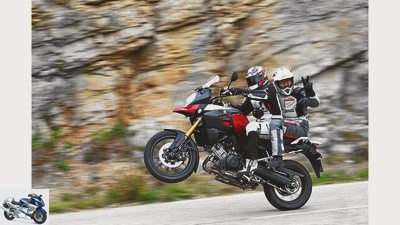
8/37
Suzuki V-Strom 1000: Take two. Passenger operation can use the V-Strom. The passenger sits a little more cramped than on the Kawasaki.

9/37
Triumph Tiger 1050 Sport: Not bad. Nevertheless, the Tiger only offers the third-best seat in the second row in this test field.
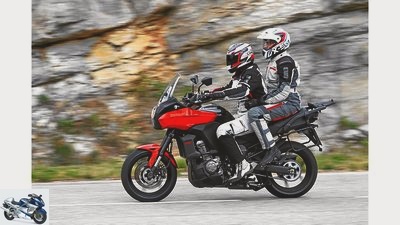
10/37
Kawasaki Versys 1000: Plush: the best seating comfort in front and behind. Bedded on thick seats, garnished with comfortable knee angles.

11/37
Who ever said that you needed even more power and displacement on winding country roads?

12/37
Well then: The trio completes voyages of discovery on badly torn asphalt.
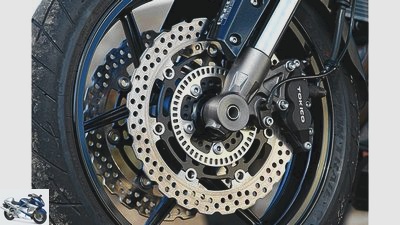
13/37
Kawasaki Versys 1000: brake discs with serrated edge. Subjectively, the Tokico stoppers appear dull and cannot be precisely dosed.
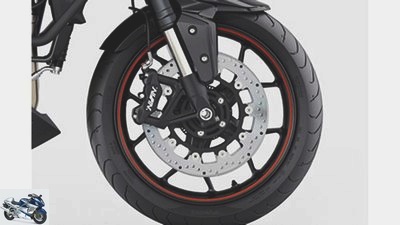
14/37
Triumph Tiger 1050 Sport: Everything so beautifully radial here. The stoppers with Nissin ABS grip almost a little too abruptly or even poisonously under a fine effect.
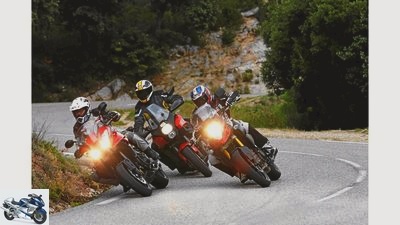
15/37
Who better embodies the golden mean with generously dimensioned 1000cc engines: two-, three- or four-cylinder?
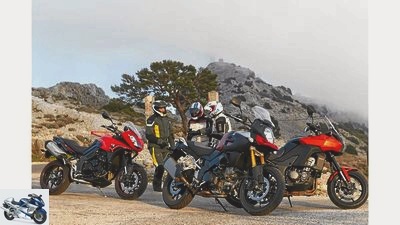
16/37
If the cold creeps under your clothes, heated grips would do really good.
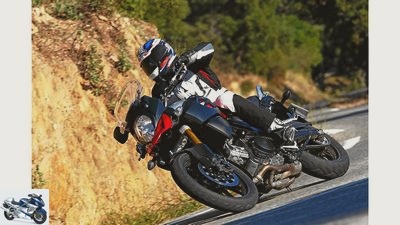
17/37
Suzuki V-Strom 1000: Insignia of the V2 newcomer: a pointed beak, a delicate front silhouette and a lot of interference between the manifolds.
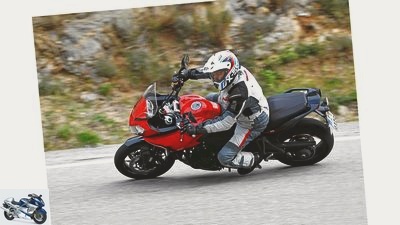
18/37
Triumph Tiger 1050 Sport: The travel enduro with its sensually roaring three-cylinder has turned into a real and stylish fun bike.

19/37
Kawasaki Versys 1000: A motorcycle like Bochum: no beauty, but good-hearted. With a strong four-cylinder and comfortable cuddly seats.
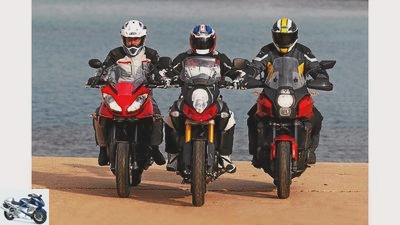
20/37
Enduro genes? Only the V-Strom carries a narrow 19-inch front wheel.
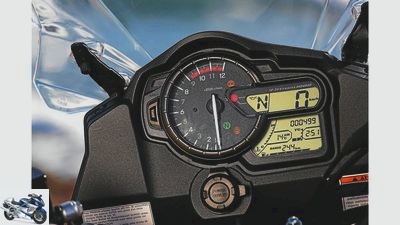
21/37
Suzuki V-Strom 1000: Sure thing. Informative on-board computer, only gear indicator, exclusive on-board socket, dimmable displays.
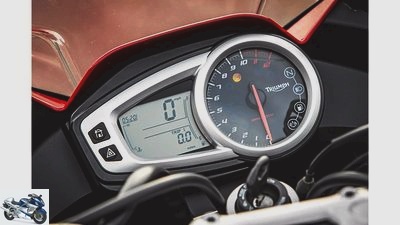
22/37
Triumph Tiger 1050 Sport: The instruments appear valuable – like the whole motorcycle. Operating the on-board computer takes some getting used to.
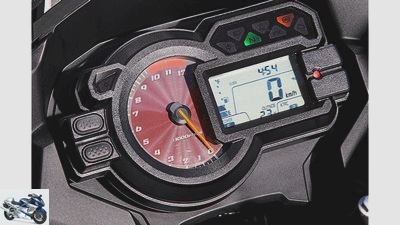
23/37
Kawasaki Versys 1000: The third analog tachometer in the league. Exclusive: reward display for fuel-efficient driving, two mappings.
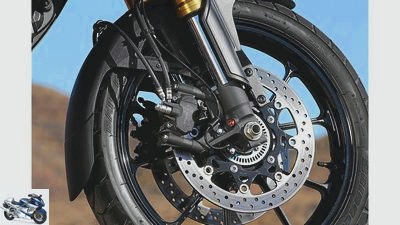
24/37
Suzuki V-Strom 1000: Snappy stoppers mark a huge difference to the previous model: one-piece four-piston calipers, screwed on radially.
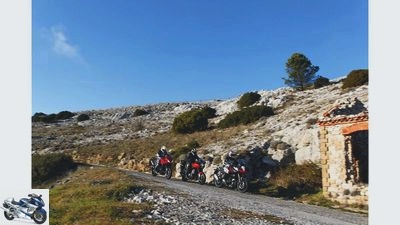
25/37
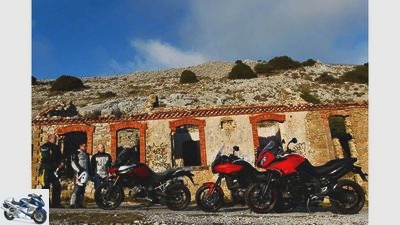
26/37
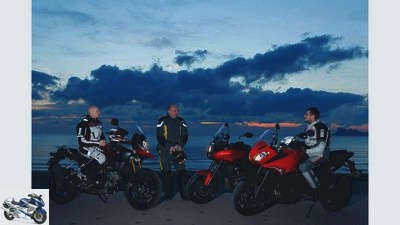
27/37
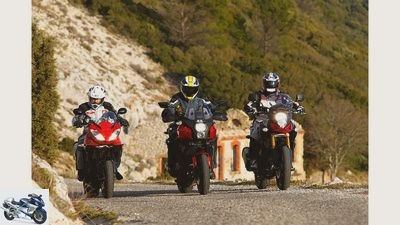
28/37
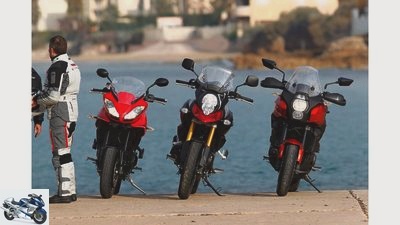
29/37
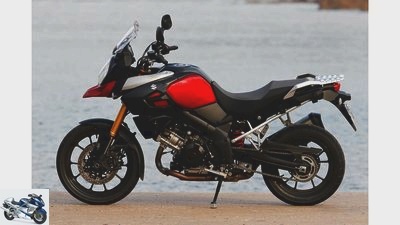
30/37
Suzuki V-Strom 1000.
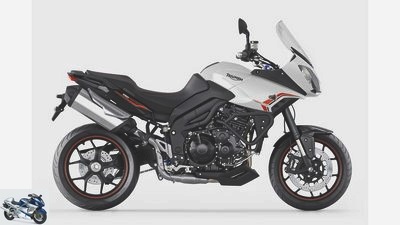
31/37
Triumph Tiger 1050 Sport.
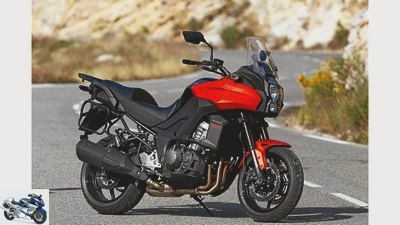
32/37
Kawasaki Versys 1000.
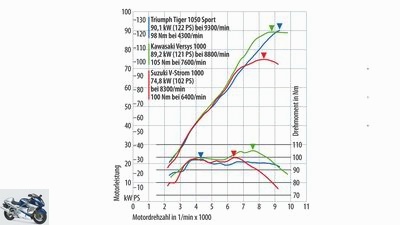
33/37
Similar and yet different. Almost congruent are the three performance curves of two, three and four cylinders in the country road relevant range up to 6000 rpm very close to one another.
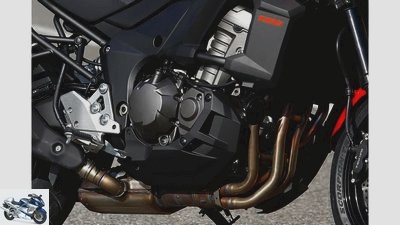
34/37
Kawasaki Versys 1000: Compact power pack. Good to see: torque-increasing interference tubes between manifolds 1 to 4 and 2 to 3.
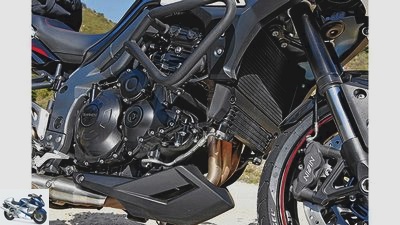
35/37
Triumph Tiger 1050 Sport: The load-bearing three-cylinder has the longest stroke of the three drives. Only he has oil and water coolers.
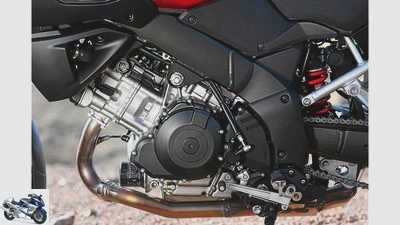
36/37
Suzuki V-Strom 1000: Does not require a balance shaft: The 90 degree angle between the cylinders ensures good mass balance; short stroke.
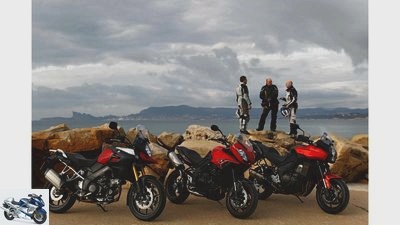
37/37
Kawasaki Versys 1000, Suzuki V-Strom 1000 and Triumph Tiger 1050 Sport in the test
1000cc travel enduro bikes with two, three and four cylinders
Suzuki’s V-Strom 1000 offers 100 V2 PS in a modern chassis. Can it hold a candle to the Kawasaki Versys 1000 and Tiger 1050 Sport? So who better embodies the golden mean with generously dimensioned 1000 cc engines: two, three or four cylinders?
1000cc travel enduro in the test
A sonorous humming swells, becomes more intense, comes closer. A polyphonic sound body, thundering and roaring. The trio has already disappeared around the next corner, three motorbikes flying in formation. With drivers sitting upright, relaxed and smiling. This is how it is when you stab through the middle with the three 1050s, between 800 and 1200 enduros. Equipped with two, three and four cylinders, there are Suzuki V-Strom 1000, Triumph Tiger 1050 Sport and Kawasaki Versys 1000 also for an attractive competition of engine concepts.
Buy complete article
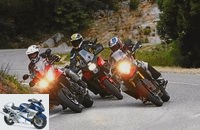
Kawasaki Versys 1000, Suzuki V-Strom 1000 and Triumph Tiger 1050 Sport in the test
1000cc travel enduro bikes with two, three and four cylinders
Wide handlebars and a lot of bang from below
What do the new sandwich class have in common? There are many. In addition to around 1000 cubic meters and prices starting at 12,000 euros, stable and light aluminum bridge frames are a must. The swingarms are also made of light metal alloys, in a two-arm design in the Suzuki V-Strom 1000 and Kawasaki Versys 1000, as a noble single-sided swingarm in the Triumph Tiger 1050 Sport, which is produced in Thailand. 43er upside-down forks and ABS are also part of the good sound, traction control not yet with Triumph.
20-liter tanks, the Kawasaki Versys 1000 bunkers an additional liter, are suitable for touring. From the driver’s perspective, wide handlebars are appealing, from 84 or 85 centimeters on the Suzuki V-Strom 1000 and the Triumph Tiger 1050 Sport to a sweeping 90 centimeters on the Kawasaki Versys. The engines, which are already powerfully pushing forward in low engine speeds, can inspire. A lot of bang from the bottom was high in the specifications for the new edition of the Suzuki V-Strom 1000. An increase in displacement to 1037 cubic serves as a power boost. It brought the V2 between 3000 and 4500 tours and between 6000 and 7000 rpm more flavor. Two torque humps with up to ten Newton meters more than before. That is a word. More top performance, now 100 instead of 98 hp, was a minor matter. In fact, as many as 102 draft horses trot, fully assembled at 8300 rpm. However, the short-stroke 90-degree V2 seems constricted above the 7000 mark, turns unemotional and tough. Its comfortable speed is around 4000. It is hard to believe that this engine was once a supersport unit in the blissful TL 1000 S. Today he embodies the good buddy more than the fiery hot spur. Hearty punch, V2 staccato, electrifying is different. The Suzuki V-Strom 1000 has clearly increased its punch and pulling power compared to the old model: Compared to the previous model from 2002 to 2008, the sixth gear is nine percent shorter.
Suzuki V-Strom 1000 with the smoothest load change reactions
In the meantime, our trio is screwing its way up infernally narrow streets to Monte Caume. The V-Twin cannot quite keep up with triple and four-cylinder in the lowest engine speed range. Uphill out of bends, the Suzuki V-Strom 1000 accelerates from 40 to 80 km / h as fast as the Kawasaki Versys 1000 and Triumph Tiger 1050 Sport, in a measured 2.5 seconds. The V-Strom only needs second gear for this, while the other two can easily master this exercise in third. In speed level three, the V-Strom needs a third longer. But what do tenths of a second count, are we here to travel or to race? A grandiose backdrop spreads out in front of us. Like toy boats, warships and aircraft carriers of the French Navy lie miles away in the port of Toulon. Take a deep breath, take off your helmet.
Okay, so the three- and four-cylinder units are more elastic from below and easier to turn from above. But the V2 of the Suzuki V-Strom 1000 shines with the smoothest load change reactions. Its performance begins with gas on, gas on, gas on again, soft and predictable. Suzuki has double throttle valves fully under control: One is operated by the driver, the other by the computer. Depending on the speed, speed and gear engaged, this improves the flow in the engine and smooths transitions. Although Kawasaki also uses this technology, the Versys accelerates harder out of rolling phases.
Triumph Tiger 1050 Sport is an emotional flatterer
The Triumph Tiger 1050 Sport jumps forward particularly harshly from push mode when you pull it back on. Well, the 125hp engine doesn’t have secondary throttles. In return, the triple responds finely, directly and highly motivated to the pull on the purely mechanical cable. The triplet embodies old school, is an emotional flatterer. Its rattle, hiss and growl get under the skin. Even torque curve, the longest-stroke design and the shortest overall transmission add up to a lively acceleration. From 3500 to 9000 tours the triple always piles up 95 Newton meters, around the 4000 mark even a shovel more. The usable speed range of the three-cylinder is wide. The 1050 is always there. With the standard exhaust, the only raised horn of this trio, up to 123 hp can be found. In addition, the turbine-like triple beguiles with a cultivated run, pulsates nice and soft. One forgives a little play in the drive train and the violent load change reactions. Or the bony Brit gearbox. The rarely necessary gear changes always feel a bit uncomfortable.
Triumph’s cable clutch can be fine-tuned, but it needs a firm hand. The hydraulic clutch of the Suzuki V-Strom 1000 does the opposite: Its hand lever, which is also adjustable, can be easily pulled thanks to the servo function. But the engagement, especially when moving off, cannot be regulated very sensitively. Strangely, the slipper clutch only engages the last millimeter of lever travel. Fog drifts up the slopes, suddenly cold creeps under your clothes. Just back down into the valley. Heated grips are now missing.
Kawasaki Versys 1000 with beefy thrust
Okay, the Kawasaki clutch grabs when starting: grips, doesn’t grip, grabs. And the lever is not adjustable. So what? Would someone blame a Chevrolet Camaro for not switching through its automatic transmission gently? The four-cylinder is about as emphatically pushing the engine down in revs. Gentle violence! Which turns into pure anger at 6000 to 8000 revolutions. Then there are always over 100 Newton meters. Clean. Now the Kawasaki Versys 1000 just zooms in on the horizon. Almost faster than you would like on tour.
Again and again on the Versys you try to shift up again in the sixth, that’s how brawny the thrust is. Inconspicuously fast. Gently but firmly it presses the bowels together. The engine of the 2010 Z 1000 was tamed for use in the all-rounder. Or better said: bearded. Tamer camshafts and the compression reduced from 11.8 to 10.3 cut the peak power by 20 to 118 hp. With the optional Akrapovic exhaust, the 1043 cubic unit delivers real 121 hp. It prottelt dull and sonorous, with a hoarse base note. But also subtle because it is well damped. Chubby? No thanks. In rain mode, only the Kawasaki Versys 1000 offers two different engine mappings, it is around 25 percent less. A sleek and very sophisticated drive, this four-cylinder. Only at medium to higher speeds do high-frequency vibrations creep into the deepest footrests. Despite the balance shaft. Regardless, such four-cylinder engines made Japan big and powerful for a reason!
The dimensions of the long-legged Kawasaki Versys 1000 only appear expansive when standing. When driving, it can be directed to the point with its wide (almost over-wide in traffic jams) enduro handlebars. The easiest steering with the shortest wheelbase, follows the chosen line most precisely. The perfectly balanced, gentle giant conveys a lot of trust. The three-stage traction control, which covers the entire spectrum from early intervention to the “seat belt for an absolute emergency”, also contributes to this.
Versys – cheeky like an athlete, comfortable like a tourer
The two distinguishable stages of Suzuki’s first ever traction control work more defensively and carefully. It can also be switched off for off-road use, and gives a feeling of security or impossibility to fall. The Triumph Tiger 1050 Sport is missing that. Anyone who has never missed traction control before will be amazed at the meanwhile flooded streets what difference it makes in their heads. Just try to follow the Nippon duo without a safety net. It’s hardly possible to relax.
In addition, the well-balanced Kawasaki Versys 1000 pampers you with the best seat and suspension comfort in the field, cushions and cushions even the worst roads. “I’ll get you through there,” a voice whispers to you in her plush Pullmann seat. Now you know why petite women like to cuddle up to tall men. This protector syndrome of wonderful security is perfectly embodied by the good-natured Kawa character. Cheeky like an athlete, comfortable like a tourer. From a static point of view, the Versys shock absorber is located on the soft side. The laxly damped rebound stage allows it to rebound quickly. Tip: turn it far. The fork works rather tightly, you almost have to force it to compress because of the high breakaway torque. But that’s fine when driving. The limit only comes when you ride parforc on bad asphalt. Then the tame, soft Versys sets limits and seems overwhelmed. It is really lighter than it looks: 241 kilograms. Equipped with steel pannier racks, a main stand that can be easily jacked up and clumsily mounted hand protectors, it’s 249 kilograms. The sparsely equipped Tiger even weighs a full 256 kilos. Triumph’s sleek pseudo-athlete hardly shows his fat. Visually, it is the only machine that looks wiry, sinewy and chic, really suitable for street cafes. In contrast to the ugly duckling from Versys.
Pushing and maneuvering? Preferably the Suzuki V-Strom 1000!
Cafe au lait for everyone. Now beautiful Tiger details such as aluminum handlebars and powder-coated aluminum frame come into their own. How was that before? The Kawasaki Versys 1000 and the Triumph Tiger 1050 Sport react sensitively to bumps in the slope. Then they stand up noticeably over their wide 180 mm tail flaps, follow asphalt faults and deviate from the desired course. You have to be prepared for it. After all, the Pirelli tires from Versys and Tiger are sticky, trustworthy. What the Bridgestone Battle Wing (in the back in special code “J”) of the Suzuki V-Strom only do to a limited extent. In a cold state when driving off in the morning, they offer little grip and feedback.
At the first steering impulse, the Suzuki V-Strom 1000 seems a bit stiffer than the Kawasaki Versys 1000. Longest wheelbase and caster meet 19-inch models. In return, the V-Strom stays on course more neutrally on the humped, pitted terrain, is imperturbable and sociable. Narrow tires, 110 and 150. Ultimately, their modern spring elements offer the most reserves and put away the most. Longest suspension travel. The design in the direction of travel enduro pays off. In contrast to the previous model, a moderately appealing, stucky fork – still conventional at the time – is now history. The feel-good factor is hardly inferior to that of the Versys. This is mainly due to the light 229 kilograms including the most delicate silhouette.
Pushing and maneuvering? Preferably the Suzuki V-Strom 1000! However, you sit on the V-Strom behind the narrowest handlebar with your legs a little apart. Hey, shouldn’t a V2 be narrower? The Triumph Tiger 1050 Sport spreads its tamer’s legs particularly wide. Their high, shapely footrests are the last furrows in the asphalt. But they require a very sharp knee angle for tall guys. Sporty. It drives like a normal street motorcycle, the Triumph. The coordination of the chassis fits in with this. The spring elements respond dry, wooden. After all, its adjustment range is large, even if there is no practical handwheel. No, the Triumph Tiger 1050 Sport does not want to be a comfort litter. But crisp in curves, with the steepest steering head and the shortest caster. Be careful when you grip the Tiger brake in an inclined position: Then the low-lying, heavily weighted front suddenly folds down further and you need to correct it. So it is better to brake to the end before the curve.
Well then: The trio completes voyages of discovery on badly torn asphalt.
The Suzuki V-Strom 1000 can do that better, as it proves on the climb to the Col de l’Espigoulier. The new monoblock four-piston stoppers from V-Strom are easy to dose, and the Suzi are the least likely to stand up. Your latest generation Bosch ABS controls more finely than that of the Triumph. Subjectively somewhat diffuse, without a crystal-clear pressure point, the structurally simpler Kawa stoppers grab hold of it.
Settlement at home, on German autobahns. Beyond 180 km / h, the Suzuki V-Strom 1000 gets a bit tough. For this, the height and tilt of the disc, which is smartly adjustable, provides the best protection. And the tendency of the old V-Strom to oscillate is a thing of the past with the new model. Without a case (they were not yet available), the slim 1000 series runs steadfastly in a straight line. It is louder, less sheltered on the Kawasaki Versys 1000, the draftiest on the Triumph Tiger 1050 Sport. Touring screens cost, of course, an extra charge. The cost prices of a good 12,000 euros are not overly cheap.
Especially since accessories, especially for Suzuki and Triumph, are steep to outrageously expensive. Three small plastic luggage boxes for around 1500 euros (V-Strom). Or two tiger suitcases for a whopping thousand. Hello, are you still okay? In addition, there are cheeky 395 euros in additional costs at Triumph. Kawasaki does better. Deliveries for half, equips the special model Grand Tourer with full equipment for just 1000 euros extra.
Basic engines have already proven their durability in long-term tests
Would it be any wonder if, given such prices, potential customers would rather buy a GS, Explorer or Super Tenere? They are still “naked” for around 15,000 euros, but offer more pressure, equipment options and aura. Good to know: The basic engines of all three types have already brilliantly proven their durability in the MOTORRAD endurance test. In 2013, Kawasaki Versys 1000 and Triumph Tiger 1050 Sport drove with 300 to 400 new sales in Germany rather under “also ran”. Suzuki sees real potential in the new 1000 class. The brand’s first motorcycle with a laudable 12,000 service interval is expected to find up to 1,500 buyers in this country in the first year.
Now the heavily revised Suzuki V-Strom 1000 is the golden mean of this trio. Not the most sensual machine, however. No synapses explode in the brain while driving. The Triumph is more emotional, cozier, more bearish, the Kawasaki. The economical V-Strom is almost a rational motorcycle. Is that enough to distract you from the really good V-Strom 650, which is currently 5,000 euros cheaper in the same shop? And with Kawasaki and Triumph, there are significantly cheaper candidates next door in the form of the Versys 650 and Tiger 800. That would be the next golden triangle.
Technology engine science
The engine configuration influences the maximum possible horsepower yield as well as the type of power output and the torque curve. Not to forget the sound.
First of all, more cylinders with a similar displacement mean smaller pistons, each with less weight and overall less mechanical stress. Because the torque of a cylinder is only effective during the power cycle, the more cylinders an engine has, the more even the torque output. In principle, large combustion chambers make gas changes and therefore efficient filling as well as complete and therefore clean combustion more difficult. Therefore, in motorcycle engines with their high speeds and therefore very short time intervals for the individual cycles, individual cubic capacities of up to 300 cm³ are particularly easy to control from a combustion point of view.
V-Strom with two spark plugs per cylinder
Since the Suzuki V-Strom 1000 with 518.5 cm³ is significantly higher. 100 millimeters bore are two more than the old V2 with a total of 996 cm³. And that already failed because of the current Euro 3 emissions standard. In order to reduce the flame paths, the heavily revised engine received two spark plugs per cylinder, including new software and a faster on-board computer. The basic principles of the 90-degree V2 have remained: for example the uneven firing sequence (firing interval first 270, then 450 degrees) and the resulting sound. Likewise a good mass balance, which makes a balance shaft unnecessary. On the other hand, the higher construction costs with two separate cylinders and the rather large length of the V-engine.
Conversely, there is plenty of space in the space between the cylinders for the fat 45 mm throttle valve bodies. A special feature of the Suzuki engine that originally fired the TL 1000 S: the camshaft drive via an intermediate shaft per cylinder head, which drives the two camshafts via gear wheels. This advantageously results in short timing chains with low chain vibrations – good for precisely adhered to timing as well as low and narrow cylinder heads.
The Triumph-Triple carries its three crank pins offset by 120 degrees on the crankshaft. This results in a constant firing order every 240 degrees (order: cylinders 1-3-2) as well as the linear power output and the sound of a “six-cylinder cut in half”. As such, three-cylinder engines promise a compact design; in reality, the old 1050 engine is rather bulky and heavy. The largest stroke in percentage terms (90 percent of the bore!) Brings a lot of power from below. Kawasaki’s compact four-cylinder, which was completely redeveloped for the Z 1000 in 2010, comes close to “ideal” individual displacement and therefore, like the Triumph Tiger 1050 Sport, manages with single ignition. And like this one also with a balancer shaft. The four-cylinder naturally fires steadily and full every half crankshaft revolution. Like the Suzuki V2, the four-cylinder has two throttle valves per cylinder.
Performance measurement
Power on the crankshaft. Measurements on the Dynojet roller test stand 250, corrected according to 95/1 / EG, maximum possible deviation ± 5%.
Similar and yet different. Almost congruent are the three performance curves of two-, three- and four-cylinder in the country-relevant area up to 6000 rpm, very close together. Kawasaki’s four-cylinder pushes the hardest at mid-rev. And then really unleashed from the 6000 mark. The Suzuki-V2 experiences its second spring between 6000 and 7000 tours. But directly above the V-Twin brushes the sails, he runs out of breath early. The triple by Triumph pushes in an even and linear manner. Its weakest torque is hardly noticeable in between. Especially since the freedom of rotation is right like with the Versys. However, other Tiger models with Arrow exhausts had more oomph.
Equipment in detail
| Kawasaki Versys 1000 | Suzuki V-Strom 1000 | Triumph Tiger 1050 Sport | |
| cockpit | |||
| Average / instantaneous consumption |
¹In the special Grand Tourer model (for a total of 1000 euros extra) included; ● = series, (-) = not available
Data and measured values
Pirelli Angel ST, front"A."
¹MOTORCYCLE measurements; ²Price including Akrapovic exhaust (622.25 euros), main stand (179.95 euros), carbon exhaust cover (149.95 euros), hand protectors (125.05 euros)
MOTORCYCLE test results
Suzuki V-Strom 1000
Made-to-measure debut. Blessed with the favor of the new, Suzi drives forward. Its plus points are the superior chassis, many fine details and 12,000 service intervals. The V2 is economical and low in load changes, but not very easy to turn – more sensible than sensual.
Kawasaki Versys 1000
The gentle giant is not only lighter on the scales than it looks. It is also very agile: handy, good-natured and extremely comfortable. The powerful four-cylinder is a source of joy. Which can hardly apply to the unaesthetic appearance. The inner values count (and are right) here!
Triumph Tiger 1050 Sport
Lots of fun and lots of bikes: the athlete is a little pug, the heaviest motorcycle in the field. You can see this, as well as small nicknames and the sparse equipment, because you easily succumb to the charm of the inspiring three-cylinder.
MOTORCYCLE scoring
| maximum number of points | Kawasaki Versys 1000 | Suzuki V-Strom 1000 | Triumph Tiger 1050 Sport | |
| engine | ||||
| Draft | 40 | 30th | 29 | 29 |
| acceleration | 40 | 29 | 19th | 28 |
| Top speed | 30th | 18th | 14th | 17th |
| Engine characteristics | 30th | 24 | 22nd | 25th |
| Responsiveness | 20th | 12th | 12th | 13 |
| Load change | 20th | 12th | 14th | 11 |
| Smoothness | 20th | 13 | 11 | 15th |
| coupling | 10 | 8th | 7th | 7th |
| circuit | 20th | 14th | 13 | 12th |
| Gear ratio | 10 | 8th | 8th | 8th |
| Start | 10 | 8th | 9 | 8th |
| total | 250 | 176 | 158 | 173 |
There is no mistaking it: The Versys four-cylinder tears the strongest. In terms of acceleration and torque in the sixth, he is just ahead of the beautifully smooth running Triumph Triple: The Triumph vibrates little and reacts most directly to gas commands. Your downer is the bony gears and more armored load change reactions. Such are almost completely alien to the more pulsating Suzuki. It runs not very fiery at the top, only tough up to a speed of 200 and above.
Winner engine: Kawasaki Versys 1000
| maximum number of points | Kawasaki Versys 1000 | Suzuki V-Strom 1000 | Triumph Tiger 1050 Sport | |
| landing gear |
head to head Suzuki and Kawasaki put the most highlights here. The easiest handling, the best suspension comfort and the highest steering precision speak for the Versys, better suspension elements for the V-Strom: They offer plenty of reserves such as adjustment options, and remain the most stable on poor roads. The Triumph spoils you with the greatest freedom of inclination. The feedback for what is happening should be a little better everywhere. Only with cold tires does the V-Strom drive a bit callous.
Chassis winner: Suzuki V-Strom 1000
| maximum number of points | Kawasaki Versys 1000 | Suzuki V-Strom 1000 | Triumph Tiger 1050 Sport | |
| everyday life | ||||
| Ergonomics driver | 40 | 32 | 30th | 29 |
| Ergonomics pillion | 20th | 15th | 13 | 12th |
| Windbreak | 20th | 11 | 13 | 10 |
| view | 20th | 12th | 13 | 12th |
| light | 20th | 13 | 13 | 15th |
| Furnishing | 30th | 25th | 22nd | 15th |
| Handling / maintenance | 30th | 16 | 17th | 15th |
| Luggage storage | 10 | 5 | 5 | 2 |
| Payload | 10 | 8th | 8th | 7th |
| Range | 30th | 24 | 25th | 23 |
| processing | 20th | 11 | 13 | 14th |
| total | 250 | 172 | 172 | 154 |
In the end tight: The Kawasaki offers the most comfortable “work” place – thanks to the widest handlebars and the most opulent seat. The Versys is also the most comfortable to carry a pillion passenger across the country. The large payload fits into the picture, despite the accessories. Their coarse workmanship, however, hardly. The Suzuki is very everyday, especially thanks to the best wind protection and a bit more range. The Tiger shines with a great light, but fails because of the missing luggage rack and many small nicknames.
Everyday winners: Kawasaki Versys 1000 / Suzuki V-Strom 1000
| maximum number of points | Kawasaki Versys 1000 | Suzuki V-Strom 1000 | Triumph Tiger 1050 Sport | |
| security | ||||
| Braking effect | 40 | 28 | 28 | 28 |
| Brake metering | 30th | 19th | 22nd | 21st |
| Braking with a passenger / fading | 20th | 13 | 13 | 13 |
| Righting moment when braking | 10 | 7th | 8th | 7th |
| ABS function | 20th | 14th | 14th | 12th |
| Handlebar slapping | 20th | 15th | 15th | 15th |
| Ground clearance | 10 | 7th | 8th | 8th |
| total | 150 | 103 | 108 | 104 |
High level. The whole trio is convincing in terms of braking performance. But with clear transparency only the V-Strom. With its narrow front tire, it stands up less when braking in an inclined position. Like the Triumph, the Suzuki enjoys a fairly high ground clearance. The Tiger ABS could regulate more finely.
Safety winner: Suzuki V-Strom 1000
| maximum number of points | Kawasaki Versys 1000 | Suzuki V-Strom 1000 | Triumph Tiger 1050 Sport | |
| costs | ||||
| guarantee | 30th | 15th | 17th | 17th |
| Consumption (country road) | 30th | 17th | 19th | 17th |
| Inspection costs | 20th | 12th | 18th | 16 |
| Maintenance costs | 20th | 8th | 11 | 8th |
| total | 100 | 52 | 65 | 58 |
The Suzuki V-Strom 1000 sets itself apart: with the lowest possible fuel consumption, mobility guarantee like the Triumph and long, 12000 service intervals.
Winner cost: Suzuki V-Strom 1000
| maximum number of points | Kawasaki Versys 1000 | Suzuki V-Strom 1000 | Triumph Tiger 1050 Sport | |
| Overall rating | 1000 | 666 | 671 | 648 |
| placement | 2. | 1. | 3. | |
| Price-performance note | Top grade 1.0 | 1.9 | 1.9 | 2.3 |
Price-performance winner: Kawasaki / Suzuki
Gold twice for Japan, for Kawasaki Versys 1000 and Suzuki V-Strom 1000. Great Britain has to be content with the bronze medal.
Related articles
-
Comparison test: naked bikes BMW, Ducati, Triumph, Yamaha, Kawasaki
fact 66 pictures fact 1/66 If you want a real all-rounder, the Yamaha FZ8 is the right choice. fact 2/66 No trace of saving: Despite the …
-
Comparison test touring enduro bikes: Honda Transalp, Kawasaki Versys, Suzuki V-Strom 650
Jahn comparison test travel enduro: Honda Transalp, Kawasaki Versys, Suzuki V-Strom 650 Always on the wall, travel enduro does not necessarily mean BMW …
-
Comparison test travel enduro bikes: Part 3
25 pictures 1/25 Comparison test travel enduro 2013. 2/25 Comparison test travel enduro 2013. 3/25 Always on …
-
Triumph Daytona 675, Kawasaki ZX-6R 636 and Suzuki GSX-R 750 in the test
fact 20 pictures fact 1/20 super athlete with less than 1000cm³ in the comparison test. Suzuki GSX-R 750, Kawasaki ZX-6R 636 and Triumph Daytona 675. fact 2/20 …
-
Kawasaki Versys 1000, Triumph Tiger 1050 Sport, Honda Crossrunner in comparison test
28 pictures 1/28 After the romping comes the touring: petrol talks at the former coal port in Karlsruhe ….
-
Jahn comparison test of supersports: Ducati 998, Honda Fireblade, Kawasaki ZX-9R, Suzuki GSX-R 1000, Triumph Daytona 955i Centennial The K-Question Five …
-
Comparison test KTM 1050 Adventure, Suzuki V-Strom 1000 and Triumph Tiger 800 XRx
Gargolov 38 pictures Gargolov 1/38 Triumph Tiger 800 XRx. Gargolov 2/38 The KTM damper with adjustable spring base and rebound stage is directly linked …
-
Suzuki V-Strom 650 and Kawasaki Versys 650 in the test
fact 27 photos fact 1/27 Suzuki V-Strom 650. fact 2/27 … The cases (28 liters each) fit harmoniously, partly painted in motorcycle color and narrow, in…
-
Comparison test sports tourer Kawasaki Z 1000 SX Tourer, Triumph Sprint GT
www. 35 pictures www. 1/35 Sports tourers sit between all chairs, but the temptation lies in this niche: there are bikes, …
-
Gargolov comparison test travel enduro bikes: Aprilia ETV 1000 Caponord, BMW R 1150 GS, Honda Varadero 1000, Suzuki DL 1000 V-Strom, Triumph Tiger 955i …